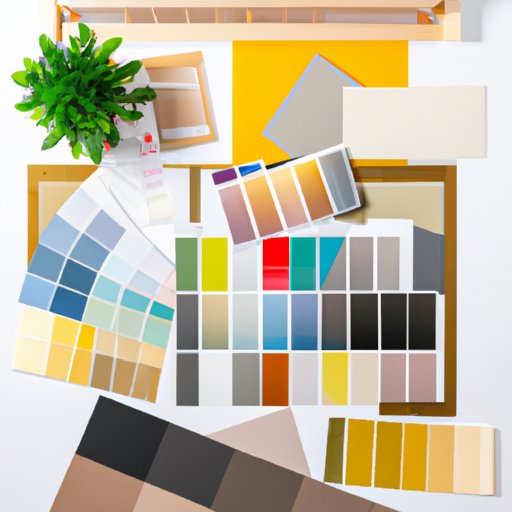Introduction
Interior design is the reflection of our personalities, and creating a mood board helps us visualize our designs before executing them. Mood boards help us explore colors, patterns, and textures and give us a better understanding of how they blend together. In this article, we will delve into the details of creating an interior design mood board, step-by-step.
Step-by-Step Guide
A mood board is a collection of images, colors, and textures that come together to create an overall look and feel. Creating a mood board is a critical step in the design process as it allows designers to visualize and plan how design elements come together. Here’s a step-by-step guide to creating an interior design mood board:
1. Determine Your Style
Before you begin collecting images and textures, it’s essential to determine your design style. Are you drawn to minimalist or eclectic designs? Rustic or modern? Once you identify your style, it becomes easier to curate images and colors that fit within your design aesthetic.
2. Choose Your Color Palette
Select a color palette that reflects your design style. Consider hues that complement or contrast to create a cohesive look. If you’re having trouble identifying colors that work well together grab a color wheel and explore the various color options.
3. Gather Inspiration
Images serve as the foundation of your mood board. Pinterest, Instagram, and magazines serve as excellent sources for inspiration. Collect as many images as possible, narrowing them down based on themes, colors, or styles. Keep in mind that your mood board should tell a story.
4. Organize and Edit
Once you have your inspiration, it’s time to organize and edit your images. Start by organizing your images by color, pattern, or style. This makes it easier to determine which images complement each other. Edit your selections, keeping only the ones that add to your story.
5. Create Your Mood Board
Now it’s time to create your mood board. Choose a backing, whether corkboard, poster board, or digital template. Start by positioning the largest pieces first, then the medium-sized images, and finally the smallest ones. Take your time to experiment with different layouts, making sure to leave enough white space between images to make them pop.
Gather Inspiration
Before creating your mood board, it’s essential to gather inspiration. Here are some tips:
1. Search for Inspiration Online
Instagram, Pinterest, and design websites serve as excellent sources of inspiration. Search by your design style, color palette, and themes that tell a story.
2. Collect Magazines
Magazines are a great source of inspiration. Rip out pages that inspire you and create a collage of images and textures.
DIY Templates
DIY templates provide a starting point for your mood board. Here are some tips:
1. Blank Grids or Papers
Blank grids or papers provide an excellent foundation for your mood board. Use them to play around with different color palettes and textures.
2. Premade Designs
Pre-made designs jumpstart the creative process. Seek inspiration from design websites or create your own templates to fit your aesthetic.
Use Online Resources
Online platforms such as Canva and Adobe Spark allow designers to create mood boards digitally. Here’s how:
1. Select a Template
Choose a pre-designed template that fits your aesthetic.
2. Upload Images
Upload images that match your color palette and design style.
3. Organize and Edit
Organize and edit your images, leaving enough white space for them to stand out.
4. Experiment with Layouts
Experiment with different layouts, moving images around until the mood board comes together perfectly.
Showcase Your Creation
Here’s an example of a mood board I created:

To create my mood board, I first determined my design style – rustic minimalism. Next, I chose a color palette with hues of neutral oranges, grays, and browns. I gathered inspiration from Instagram and Pinterest, collected my images, and edited them based on my themes. Finally, I created my mood board using a corkboard layout.
Conclusion
A mood board is a crucial step in the interior design process. It helps designers zero in on their vision and create a cohesive space. Creating a mood board can feel overwhelming, but with our step-by-step guide, you’re sure to come out with a stunning design.
(Note: Is this article not meeting your expectations? Do you have knowledge or insights to share? Unlock new opportunities and expand your reach by joining our authors team. Click Registration to join us and share your expertise with our readers.)
